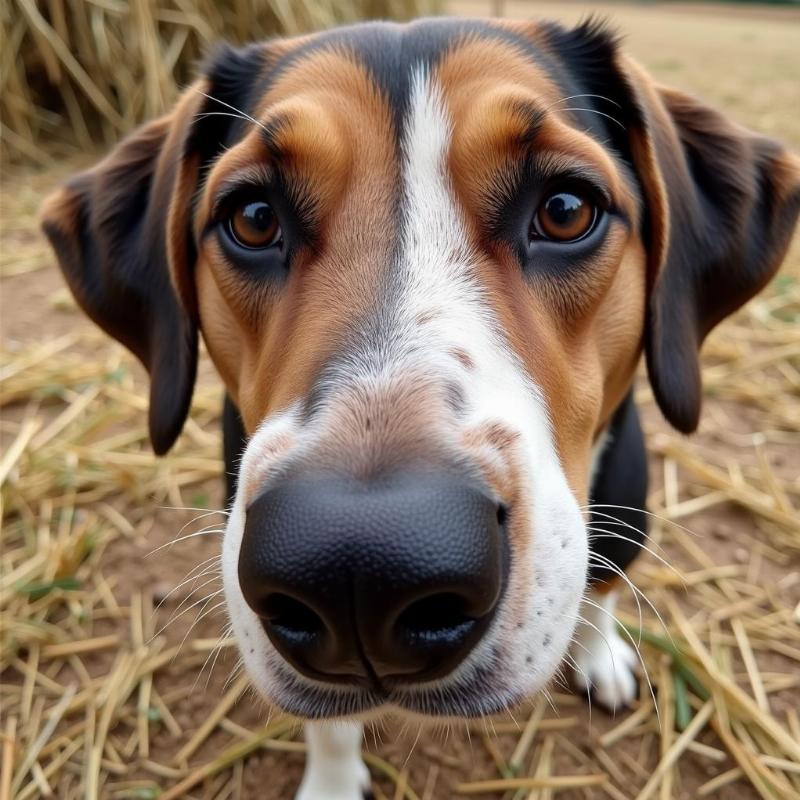Hay is a readily available and seemingly natural choice for dog bedding, evoking images of cozy barns and rustic charm. But is hay truly a good option for our canine companions? This article delves into the pros and cons of using hay for dog bedding, exploring safer and more comfortable alternatives available in the US market. We’ll discuss important factors to consider to ensure your furry friend has the best possible sleeping experience.
Exploring Hay as Dog Bedding: Pros and Cons
While hay might seem like a cost-effective and natural bedding solution, it carries several potential drawbacks that make it less than ideal for dogs. Let’s weigh the pros and cons to help you make an informed decision.
Pros:
- Availability and Cost: Hay is readily available, especially in rural areas, and is often significantly cheaper than other bedding materials.
Cons:
- Allergies and Respiratory Issues: Hay is a known allergen for both humans and dogs. It can trigger sneezing, coughing, and even asthma attacks in sensitive individuals. Dust mites, mold, and pollen often thrive in hay, exacerbating these issues.
- Parasites and Pests: Hay can harbor fleas, ticks, mites, and other parasites that can infest your dog and your home. This poses a significant health risk to your pet and requires consistent pest control measures.
- Poor Insulation and Comfort: Hay doesn’t offer the same level of insulation and comfort as purpose-made dog beds. It can become compressed and lose its cushioning, leading to pressure points and discomfort for your dog, especially for senior dogs or those with joint issues.
- Mess and Maintenance: Hay is messy and can easily scatter around your home. It requires frequent cleaning and replacement, which can be time-consuming and inconvenient.
- Potential for Ingestion: Dogs, especially puppies, may be tempted to ingest hay, which can cause digestive upset or blockages.
 Dog Showing Allergies from Hay Bedding
Dog Showing Allergies from Hay Bedding
Safe and Comfortable Bedding Alternatives for Dogs in the US
Fortunately, the US market offers a wide variety of safe and comfortable dog bedding options designed to meet your dog’s specific needs and preferences. Here are a few popular choices:
- Orthopedic Beds: These beds provide excellent support for senior dogs or those with joint problems. They are typically made of memory foam or other supportive materials that conform to the dog’s body, reducing pressure points and promoting better sleep.
- Washable Dog Beds: These beds are easy to clean and maintain, making them a hygienic choice. They come in a range of materials, including fleece, cotton, and synthetic fabrics.
- Elevated Dog Beds: These beds keep your dog off the ground, promoting airflow and preventing overheating, particularly beneficial in warmer climates. They are also easy to clean and offer good support.
- Cedar Chips: Cedar chips are a natural bedding option that can repel fleas and ticks. However, some dogs may be sensitive to the cedar scent, so it’s important to monitor your dog for any adverse reactions.
Choosing the Right Bedding for Your Dog
When choosing dog bedding, consider your dog’s age, size, breed, and any specific health needs. Factors like climate and your lifestyle also play a role. For instance, a dog living in a cold climate might benefit from a thicker, more insulated bed.
Conclusion
While hay might seem like a readily available and affordable option, it’s generally not recommended for dog bedding due to potential health risks and discomfort. Prioritizing your dog’s health and comfort by investing in a high-quality dog bed is essential for their overall well-being. The US market offers a wide range of options to suit every dog’s needs and budget, ensuring a comfortable and healthy sleeping experience. Choosing the right bedding will contribute significantly to your dog’s happiness and quality of life. Can I use hay for dog bedding? The answer is a resounding no.
FAQ
- What is the best type of bedding for dogs with allergies? Hypoallergenic dog beds made from materials like microfiber or memory foam are often recommended for dogs with allergies.
- How often should I wash my dog’s bed? Washing your dog’s bed every 1-2 weeks is generally recommended to maintain hygiene.
- What should I do if my dog eats hay? If your dog ingests a large amount of hay, consult your veterinarian immediately as it could cause digestive blockages.
- Are cedar chips safe for all dogs? While generally safe, some dogs may be sensitive to cedar. Monitor your dog for any adverse reactions, such as skin irritation or respiratory issues.
- Can I use straw instead of hay for dog bedding? Straw, like hay, is not recommended for dog bedding due to similar risks of allergies, parasites, and discomfort.
- What are the signs of a dog with fleas or ticks from hay? Excessive scratching, biting at the skin, and small dark specks (flea dirt) are common signs of flea and tick infestation.
- Where can I find high-quality dog beds in the US? Pet stores, online retailers, and even some department stores offer a wide variety of dog beds.
Related Articles on Beautdogs.us
Beautdogs.us is your premier online resource for comprehensive dog care information, breed guides, and top-quality product recommendations tailored for the US market. Whether you’re a seasoned dog owner or a new puppy parent, Beautdogs.us provides expert advice on all aspects of dog ownership, from nutrition and training to health and grooming. Connect with us for personalized support and explore our extensive resources to ensure your furry friend receives the best possible care. Contact us at [email protected] or call us at +1 501-555-7529. Visit Beautdogs.us today!